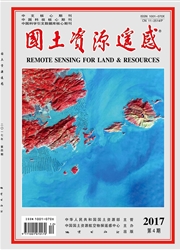

 中文摘要:
中文摘要:
针对行星多探测任务获取的海量遥感数据,提出一种基于现有参考图像匹配策略优化的自动几何精纠正技术方案。考虑到某些新传感器图像与已有参考图像的分辨率相差较大,提出了利用中间分辨率图像作为过渡的间接匹配策略;另外,针对月球和火星典型探测任务的遥感图像给出了相应参考图像的选取方法。选取嫦娥一号(CE-1)、嫦娥二号(CE-2)CCD图像和火星高解析度科学实验成像照相机(HiRISE)图像进行实验。针对CE-1和CE-2图像数据,选取月球侦察轨道飞行器宽角相机( LROC)图像作为参考;而针对HiRISE图像数据,选择以背景相机( CTX)图像为过渡、火星热辐射成像系统( THEMIS)图像为参考。利用自动匹配获取一定量的控制点,实现了行星遥感图像的自动几何精纠正。通过人工选取的检查点对纠正后图像进行精度评价的结果表明,所提出的自动几何精纠正方案是有效的,利用自动选取的控制点进行纠正后的图像定位精度明显提高,对月球和火星遥感图像的几何处理有实用价值。
 英文摘要:
英文摘要:
Aimed at efficient processing of the massive image data obtained by multi - sensors in planetary exploration missions,the authors proposed a solution to automatic accurate geo-rectification of the remote sensing images by matching them to the available reference images,which are already mapped into certain coordinate frame. Considering the large resolution gap between some of the images, this paper recommended an indirect matching strategy. The authors also tackled the problem concerning the choice of the appropriate reference image according to the characteristics of the typical lunar and Mars images. Using CCD images of CE -1 and CE -2 images from Chang’E missions and HiRISE images from MRO mission,with reference images from LROC WAC and THEMIS VIS respectively,the authors conducted the experiments. The accuracy of the corrected image were evaluated with manually selected checkpoints. The results show that, by matching them with referenced images, the control points can be chosen automatically and the subsequent rectification can achieve a significant accuracy improvement compared with that without any control points. The proposed solution is effective and practical for automatic geometric processing of planetary remote sensing images.
 同期刊论文项目
同期刊论文项目
 同项目期刊论文
同项目期刊论文
 期刊信息
期刊信息
